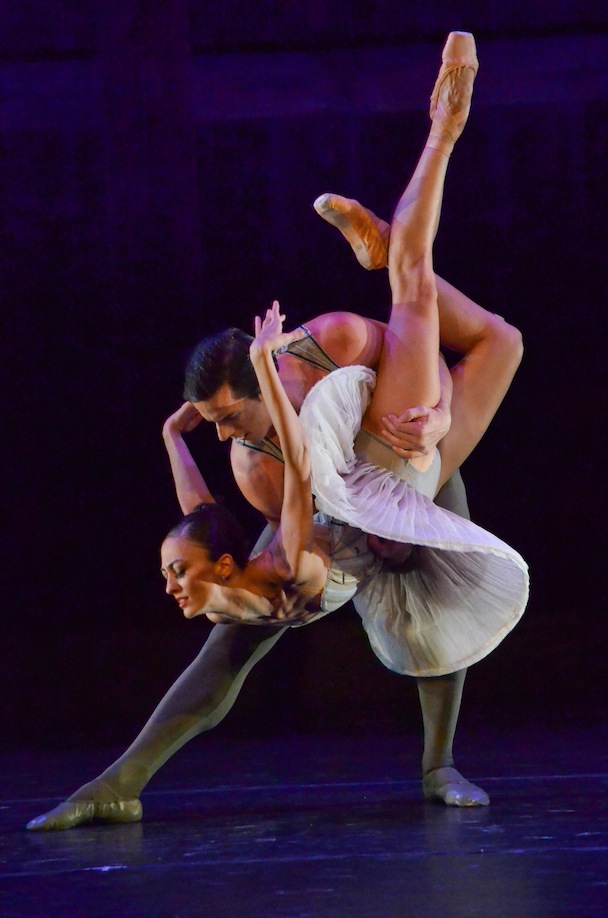
Fleet-footed dance
Joffrey Ballet was in town, all too briefly, in a showcase at Cal Performances’ Zellerbach Hall on the Berkeley campus. Deservedly, their performances were sold out.
Under the artistic direction of Scottish-born Ashley Wheater since 2007, the company continues to present new repertory based on the latest choreographic ideas and styles. On opening night the company gave a nod, a bow and flick of the wrist to the Bay Area, featuring Incantations by Val Caniparoli, who made San Francisco Ballet his artistic home for 35 years, Stanton Welsh’s ballet to John Adams’ Son of Chamber Symphony, a pas de deux choreographed by SF Ballet’s current choreographer in residence, Yuri Possokov, and Swedish choreographer Alexander Ekman’s gender-bending homage to stamina, Episode 31.
All of these ballets confirmed what has been known for some time, that the Joffrey Ballet is splendid: its dancers are an exquisite blend of thrilling technique and dynamic verve. Their athleticism is sublime.
For the most part Caniparoli’s Incantations follows Alexandre Rabinovitch-Barakovsky’s music, a driving composition that the composer describes as “a very intense panting prayer.” His “musical fleetness” creates a vortex of sound that is reflected in the red spirals decorating the dancers’ leotards and the silver spirals hanging in the smoky upper air of the stage, looking like huge egg whisks. But even more, the music’s restlessness is found in the whirling non-stop language of the choreography. It’s as vertiginous as a dance by William Forsythe, but rather than shifting abruptly from step to step and direction to direction, the choreography whirls the ensemble of five pairs of dancers in and out of shifting configurations. There is no time for hesitation.
Does Val Caniparoli sleep at night? My guess: no. Nor would it seem does Stanton Welsh, whose choreographic imagination must be filled with solutions to the question “How does one represent or dance to the pulse of John Adams’ music?” Clearly, Welsh’s metaphor is that of a clock: the dance is divided into three movements and the central motif is that of a dancer encircled by other dancers. The tiny steps of the outside dancers’ bourées mark out the jumps of the second hand, as the dancers mechanically traverse the circle of the clock face. The central dancer’s legs resemble the hands of that imaginary clock. It’s wry and clever, and far more subtle than it sounds when described. Jeraldine Mendoza and Miguel Angel Blanco danced the pas de deux that comprised the second movement. Switching from pendulum’s swing to whirling gears, Welsh’s delightful piece lay bare the complicated threads of rhythm that mesh and flow in Adams’ Son of Chamber Symphony.
Possokhov’s duet, Bells, danced by slender and long-limbed Victoria Jalani and Temur Suluashvili, each kitted out in warm red leotards, offered a complex portrait of love. Set to Rachmaninoff, the dance illuminates the back and forth resistance of romantic pursuit with its ultimate destination of surrender.
Most radical of all the pieces was Ekman’s Episode 31, which began with a video of the dancers learning the piece. There are voice-overs from the dancers telling how they saw the piece. “Stamina”, “endurance” and “community” are the key words. For the most part the choreography requires the group to repeat basic moves that could easily be used by the ’Niners during warm-ups: running in place, lifting knees high, legs spread. There are the intermittent silly gestures: finger twiddlings, hand shakings. After learning the piece, which is all done as an ensemble, the dancers take their steps to the streets, flooding train cars, buses, fountains, and city sidewalks with their concerted athletic presence. The film can be found on YouTube. Episode 31 was created for The Senior Graduation Class at The Juilliard School, 2011 in New York City.
On stage it’s a different piece: with the dancers sporting black-and-white skirts and pants. They could be a soccer or cricket team. Or maybe a Scottish public school, given the numbers of guys in white shirts, black ties and black skirts. Many wear knee-high stockings held up with black suspenders (haven’t seen those since my grandfather died!). One girl is en pointe and offers a contrast to the wave of ensemble enthusiasm.
Two be-skirted guys dance a duet. Satie’s Gymnopedie comes on and everyone briefly reverts to balletic arms and movements. A man walks across the stage carrying a sign that reads “beautiful.”
It’s all crazy, fun and fabulous.
– Jaime Robles
Photo: Victoria Jaiani and Miguel Blanco perform Stanton Welsh’s ballet set to John Adams’ Son of Chamber Symphony. Credit: Christopher Duggan
